Bulletin #2172, Raspberry and Blackberry Varieties for Maine
By David T. Handley, vegetable and small fruit specialist, University of Maine Cooperative Extension, Orono, Maine
For information about UMaine Extension programs and resources, visit extension.umaine.edu.
Find more of our publications and books at extension.umaine.edu/publications/.
Obtaining High-Quality Plants
Always start a new raspberry bed with high-quality planting stock. Poor plant material guarantees poor planting. Order your plants from a reputable source, and look for nurseries that sell plants from certified virus-free stock. This way you can be sure that the plants have been tested and found free of common viruses. Virus-free plants offer the best growth and productivity and will help the bed live longer.
Order your plants in the fall and early winter to plant next spring to avoid running into limited supplies. (Fall planting is not recommended in Maine.) Ask for a shipping date based on the date you plan to plant in the spring.
If you order raspberry plants from other countries, such as Canada, import permits are required. The plants may also have to undergo a post-entry quarantine. For more details on importing raspberry plants, contact the Maine Department of Agriculture, Conservation and Forestry at 28 State House Station, Augusta, Maine 04333-0028, or by phone at 207.287.3891.
For details on growing methods, please consult University of Maine Cooperative Extension Bulletin #2066, Growing Raspberries and Blackberries.
Types of Brambles
Growing any type of bramble successfully in Maine depends upon your site and your markets. Varieties vary considerably in their hardiness and ripening season. Only very hardy varieties with relatively early ripening seasons are likely to do well here, but growers in southern locations may be able to grow somewhat less hardy varieties with longer growing seasons than growers in more northern locations.
Nearly all summer-bearing varieties of red raspberries will suffer bud damage when temperatures drop below -20°F. Everbearing types are often mowed to the ground every spring, so sensitivity to cold temperatures is less important. However, in northern Maine, the growing season may not be long enough to ripen their fall crop. The variety ‘Heritage,’ for example, may bear the fall primocane (or first-year cane) crop too late to avoid frost injury in northern sites. These areas must be planted with earlier ripening varieties such as ‘Polana’ or ‘Joan J.’
The varieties you choose will affect the length of your harvest season. If you select an early ripening variety, a mid-season, a late-season, and a primocane-fruiting type, you can harvest berries from the end of the strawberry season to the first hard autumn frost. If you’re more interested in a concentrated season, plant varieties that have similar ripening periods.
Purple raspberries, black raspberries, and blackberries do not withstand cold temperatures as well as most red raspberries. These often will winter-kill to the snowline if temperatures drop to -15°F. This is why there are few commercial plantings in Maine. These types of berries are also more prone to certain viral and fungal infections and need extra care.
It’s important to test varieties on new sites. Despite glowing reviews from a nursery, a variety may not do well because of the particular qualities of your site (for instance, poor drainage, a short season, or low temperatures), or may not meet your customer preferences. Try new varieties in small test plots before planting them on a large scale.
Types of Planting and Growing Stock
Nurseries use several methods of propagation for bramble plants. You can choose one of the following types of plant material.
- Dormant canes or “handles” are canes with one season of growth. They are dug after becoming dormant in the fall and stored until shipping. This is a common transplant type for red raspberries and blackberries, and a wide array of varieties are available in this form.
- Tip-layered canes are the most common type of purple and black raspberry transplants. The growing tips of the plants are covered with soil in summer, causing them to root. These are separated from the cane after dormancy and stored until shipping.
- Tissue-cultured plants start in a test tube. Growing tips of plants are cut from a virus-indexed source under laboratory conditions and placed in growth chambers. This small cluster of cells gets several treatments, which cause it to form small plantlets. These plantlets are placed in sterile rooting media and grown out in greenhouses. The small plants are sold in transplant trays and can be purchased either growing or dormant, depending upon the supplier and grower. This method, although more costly, results in more uniform and disease-free plants than other propagation methods. Not all varieties are available in this form.
Choosing Varieties
Select varieties based on their intended use (such as pick-your-own, freezing, or fresh market), hardiness, productivity, disease susceptibility, fruit quality, and time of ripening. The best varieties for home gardens include ‘Boyne,’ ‘Killarney,’ ‘Reveille’, and ‘Nova’ for red raspberries; ‘Polana’ and ‘Joan J’ for everbearing varieties; ‘Royalty’ for purple varieties; ‘Jewel’ for black raspberries; and ‘Illini’ for blackberries.
Red raspberries, summer-bearing (listed by ripening date, earliest-latest)
Prelude: From New York. Ripens early. Hardy, tall, vigorous canes. Productive, with good quality fruit. May bear a small crop on primocanes in the fall, especially in southern Maine.
Reveille: From Maryland. Early ripening, very hardy. Plants are vigorous, producing many suckers. High yielding. Fruits are medium to large with good flavor but very soft. Poor shipping and freezing quality.
Boyne: From Manitoba. Ripens early and has excellent winter hardiness. Plants are spiny and produce many suckers. The fruit is small to medium in size, somewhat dark and soft, but with fair flavor and good freezing quality. Susceptible to anthracnose. Typically yields very well. Recommended for colder sites.
Killarney: From Manitoba. Sibling of ‘Boyne.’ Early ripening, slightly behind ‘Boyne.’ Plants are hardy, spiny, produce many suckers, and are susceptible to mildew. Canes are short to medium height. The fruit is medium-sized, bright red. The flavor and freezing quality are good, Susceptible to anthracnose. Recommended for colder sites.
Canby: From Oregon. Ripens mid-season, only moderate hardiness. Plants are tall, nearly thornless, and moderately productive. The fruit is medium to large, firm, bright red, with excellent flavor. Buds may winter-kill in cold climates.
Eden: A new variety from Nova Scotia. Spineless plants are hardy, with tall canes and good vigor. Fruit ripens mid-season, is large, firm, light red, and very sweet. May not be adequately hardy for more northern locations.
Latham: From Minnesota. Mid-season ripening, very hardy. Plants are vigorous with few spines. Small fruit with good color, but crumbly with only fair flavor. Ripens over a long period of time. Less susceptible to viruses than some varieties. Recommended for colder sites.
Newburgh: From New York. Mid-season ripening, hardy. Plants tall but not highly vigorous with few spines. Partially resistant to common cane diseases and root rot. Fruits are medium in size, light red, with good flavor. Maybe crumbly, and tend to ripen unevenly.
Nova: From Nova Scotia. Very hardy plants with good vigor and few thorns. This variety appears to be resistant to most common cane diseases. Attractive fruit ripens mid-season, is medium-sized, firm, bright red, and somewhat acidic.
Taylor: From New York. Late ripening, moderately hardy. Plants are vigorous with tall canes bearing some spines. Very susceptible to mosaic virus, leaf spot, and fungal diseases. The fruit is medium to large with excellent flavor, good color, and firmness.
Encore: From New York. Ripens late. Hardy, productive, vigorous plants with tall canes. Large fruit with good quality.
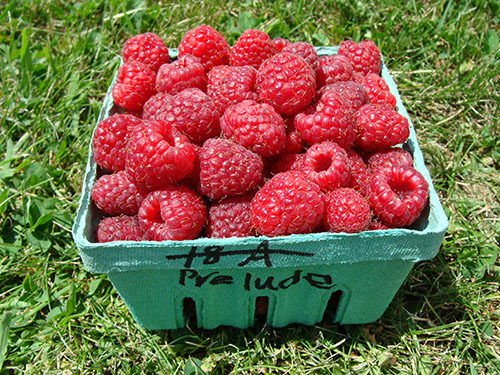
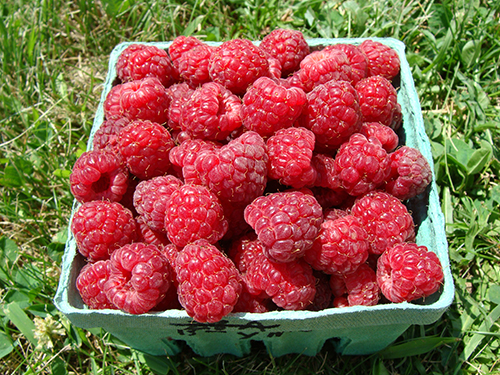
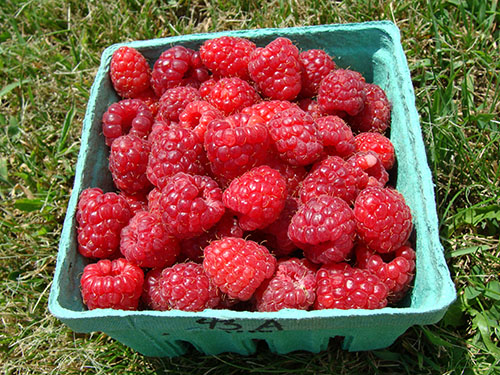
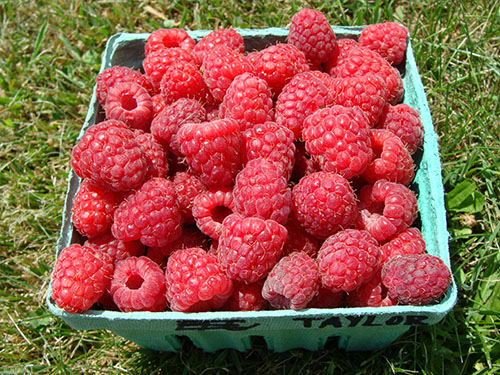
Red raspberries, everbearing (primocane-fruiting, listed by fall ripening date, earliest-latest)
Polana: Very early-ripening, vigorous, short, productive canes. Attractive small to medium-sized fruit, but many misshapen and difficult to pick. Flavor only fair. Recommended for northern areas with short growing seasons.
Polka: Early ripening, vigorous, productive, upright canes, nearly thornless. Large, dark red fruit, firm, with good flavor.
Joan J: From England. Early ripening (about the same as ‘Autumn Bliss’). Vigorous, thornless canes produce large, somewhat dark red fruit with good firmness and quality.
Autumn Bliss: From East Malling, England. Early-ripening primocane crop (late August, about two weeks earlier than ‘Heritage’). Moderately vigorous canes with few spines, slow spreading. Productive. The fruit is large and highly flavorful.
Autumn Britten: From East Malling, England. Early-ripening primocane crop, slightly later than ‘Autumn Bliss’ and with more vigorous canes. Productive. The fruit is firm and flavorful.
Jaclyn: From Maryland. Tall, vigorous canes. Early-ripening fall crop. Long, large, dark red fruit, difficult to detach from the stem. The flavor is good. Very susceptible to leaf rust disease.
Fall Red: From New Hampshire. Early-ripening primocane crop. The medium to short canes are vigorous and produce many suckers. Moderately spiny. Fruit size is medium. Good flavor, but soft. Recommended for most sites in Maine.
Caroline: From Maryland. Mid- to late-ripening fall crop, may be too late for northern Maine. Tall, vigorous plants, with medium to large good-flavored fruit. Productive.
Heritage: From New York. Primocane crop ripens relatively late, too late for all but southern Maine. Tall, rugged canes with prominent thorns. Very high yielding. Fruit size is medium, with good color, flavor, and firmness. This variety is not recommended for regions with a short growing season (frost before September 30 or cool summer temperatures).
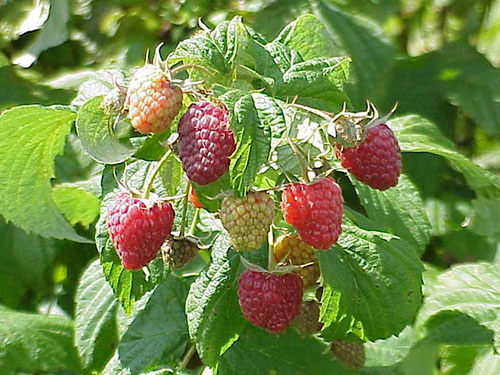

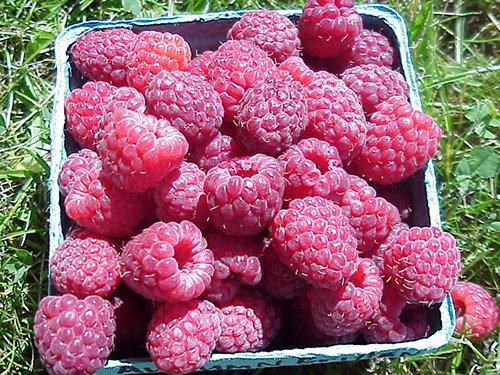
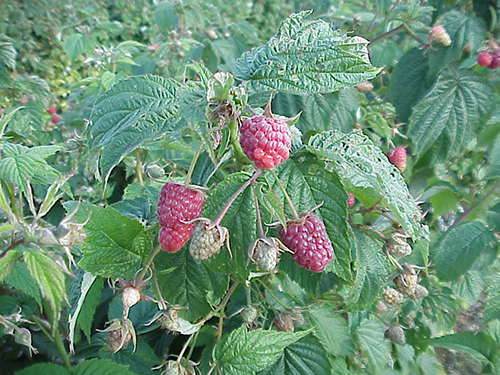
Yellow raspberries, everbearing (primocane-fruiting)
Anne: From Maryland. Fall crop ripens slightly before ‘Heritage,’ and may be too late for northern regions. Canes are tall and moderately vigorous. Fruit are pale yellow, large, with very good flavor.
Fall Gold: From New Hampshire. Primocane crop ripens relatively early. Canes are hardy and very vigorous, producing many suckers. The fruit is medium-sized, yellow with a pink blush, crumbly and soft, but with excellent flavor.
Kiwigold: From New Zealand. Derived from ‘Heritage.’ Slightly earlier than ‘Heritage;’ may be too late for northern regions. Vigorous canes, thorny, fairly tall, and productive. The fruit is yellow with dark orange to pink blush and good flavor.

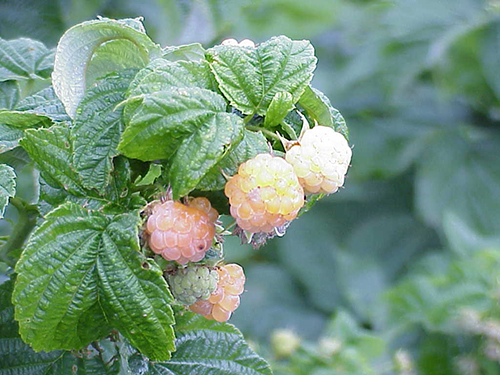
Purple raspberries, summer-bearing
In general, purple raspberries are not adequately hardy to be commercially viable in most of Maine.
Brandywine: From New York. Ripens later than most red varieties. Canes very tall and productive, with prominent thorns; suckers from crown only, will not fill in. Susceptible to crown gall, but partially resistant to many other diseases. Fruits are large, reddish-purple, and tart.
Royalty: From New York. Ripens late. Very productive canes are tall and vigorous, with thorns. Immune to the large raspberry aphid, which decreases the likelihood of virus infection, but plants are susceptible to Phytophthora root rot and crown gall. Fruit are large, reddish-purple, irregular. Fruit tends to be soft, but flavorful when eaten fresh.
Black raspberries
Black raspberries may winter-kill to the snowline if temperatures drop to -10°F. They are also quite susceptible to virus infections, Verticillium, anthracnose, and rust. They are not considered commercially viable for Maine.
Bristol: From New York. Canes are vigorous but susceptible to disease. Medium to large fruit of good quality, with good yield.
Blackhawk: From Iowa. Vigorous plants, relatively hardy and productive. The fruit is medium-large, glossy, with good flavor.
Jewel: From New York. Mid-season ripening. Possibly the hardiest black raspberry variety. Plants are vigorous, erect, and productive. Appears to have somewhat more disease resistance than other varieties. The fruit is firm and glossy with good quality.
Mac Black: From Michigan. Late ripening. Vigorous, erect canes. Medium to large fruit, soft, with good flavor.
Niwot: a new, everbearing black raspberry from Colorado. Tall, trailing canes produce a summer crop on two-year-old canes and a fall crop on the new canes starting in late August-early September. Fall crop may ripen too late and lack adequate hardiness for northern Maine. The tips of the new canes will root if allowed to touch the ground; canes should be supported with stakes or a trellis.
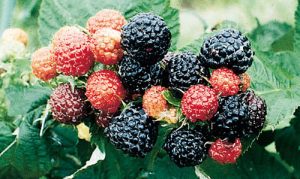
Blackberries, thorny (erect)
Erect blackberries have tall, rugged canes with prominent thorns. They are sensitive to low temperatures (-10° or colder) and are therefore not recommended for commercial production in Maine. Virus infections are common in blackberries and may cause poor winter survival and sterility, resulting in no fruit.
Darrow: From New York. Hardy. Canes are vigorous with large thorns. Good yields with long harvest season. Fruit are large and glossy, excellent quality. Susceptible to viruses, thus tends to be short-lived.
Illini: From Illinois. Hardy blackberry with large, attractive fruit. Thick, erect canes with lots of large thorns. Not as flavorful as ‘Darrow,’ but more productive.
Nelson: Propagated from an established population in northern Maine. Considered very hardy. Erect, thorny canes, best supported with stakes or trellis. Fruit are small to medium-sized with fair flavor. Not widely available.
Blackberries, thornless
Thornless blackberries have vigorous canes that must be staked or trellised. They tend to be more sensitive to winter injury than thorny varieties and are not hardy below -10°F. They should only be planted in sites protected from wind and extreme cold. They are not considered commercially viable for Maine. They ripen later than most red raspberries.
Chester: Late-season ripening, possibly hardier than other varieties. Resistant to cane blight. The fruit is of high quality, although it tends to be tart.
Triple Crown: Early-midseason ripening. Vigorous, semi-erect canes. The fruit is large with good flavor.
Note: Newer everbearing type blackberries such as Prime Jan, Prime-Ark 45, Freedom, and Traveler ripen their fall crop too late to be practical in any part of Maine and are therefore not recommended.
Information in this publication is provided purely for educational purposes. No responsibility is assumed for any problems associated with the use of products or services mentioned. No endorsement of products or companies is intended, nor is criticism of unnamed products or companies implied.
© 1995, 2009, 2020
Call 800.287.0274 (in Maine), or 207.581.3188, for information on publications and program offerings from University of Maine Cooperative Extension, or visit extension.umaine.edu.
In complying with the letter and spirit of applicable laws and pursuing its own goals of diversity, the University of Maine System does not discriminate on the grounds of race, color, religion, sex, sexual orientation, transgender status, gender, gender identity or expression, ethnicity, national origin, citizenship status, familial status, ancestry, age, disability physical or mental, genetic information, or veterans or military status in employment, education, and all other programs and activities. The University provides reasonable accommodations to qualified individuals with disabilities upon request. The following person has been designated to handle inquiries regarding non-discrimination policies: Director of Equal Opportunity and Title IX Services, 5713 Chadbourne Hall, Room 412, University of Maine, Orono, ME 04469-5713, 207.581.1226, TTY 711 (Maine Relay System).

